Learning to play the guitar can feel overwhelming at first, especially when it comes to understanding chords—the building blocks of most songs. Whether you’re hoping to strum along to your favorite tunes or start composing your own music, mastering chords is a crucial skill.
One of the most useful resources for learners is this comprehensive library of chord gitar, which provides clear chord diagrams and examples for a wide variety of songs. But before diving into specific songs, it’s worth exploring what chords are, how they’re formed, and why they matter.
What Is a Guitar Chord?
A guitar chord is a group of notes played together, typically involving three or more different pitches. On the guitar, this means pressing down on a combination of strings across different frets to produce a specific harmonic sound.
Most songs are built using a small number of chords, often repeated in a particular progression. That’s why, with just a handful of chords, you can already play hundreds of popular songs.
Major vs. Minor Chords
There are two primary types of chords that beginners should learn first:
- Major chords sound bright, clear, and happy.
- Minor chords have a more somber or emotional tone.
For example:
- C Major (C)
- A Minor (Am)
- G Major (G)
- E Minor (Em)
These chords are part of the standard set of open chords—so called because they use open strings (strings that are played without pressing any frets).
Open Chords: The Best Starting Point
Open chords are ideal for beginners because they are relatively easy to play and are used in countless songs. Some of the most common include:
- C Major
- D Major
- G Major
- A Minor
- E Minor
- D Minor
Tips for Practicing Open Chords
- Start slow. Don’t rush your transitions—accuracy is more important than speed at the beginning.
- Use a metronome. This will help you develop a consistent rhythm.
- Practice chord changes. Switch back and forth between two chords repeatedly (for example, C to G) to build muscle memory.
- Play simple songs. Start with songs that use two or three chords max.
Barre Chords: Taking It to the Next Level
Once you’ve mastered open chords, you’ll likely encounter barre chords. These involve using one finger (usually the index) to press down multiple strings across the same fret, essentially creating a “bar.”
Barre chords are more challenging but allow you to play chords in any key across the fretboard. This opens up a much wider range of musical possibilities.
Some common barre chord shapes:
- F Major (barred version)
- B Minor
- G# Minor
If your hand feels tired at first, don’t worry—that’s completely normal. Building finger strength takes time.
Chord Progressions: The Heart of Most Songs
Many songs are built on repeating chord progressions. These are sequences of chords that sound good together and are often reused in different genres and styles.
Common Progressions for Beginners
- I–IV–V: C–F–G (used in rock, blues, pop)
- I–V–vi–IV: C–G–Am–F (used in countless pop songs)
- ii–V–I: Dm–G–C (common in jazz)
By learning just a few progressions, you can play a wide range of songs—and even start writing your own.
How to Read a Chord Diagram
Chord diagrams are visual tools that show you where to place your fingers. They typically include:
- Vertical lines = strings
- Horizontal lines = frets
- Dots = finger placement
- «X» = don’t play that string
- «O» = play the string open
Taking the time to learn how to read these diagrams will make your practice sessions far more productive.
Learning at Your Own Pace
There’s no single path to learning guitar chords. Some people learn quickly by ear, while others benefit from structured lessons. What’s important is consistency—practicing even just 10–15 minutes a day can lead to significant improvement over time.
Online resources, like the chord library mentioned above, can complement your practice by giving you instant access to a variety of chords used in real songs. As you grow more comfortable, you’ll notice patterns and start predicting chords just by listening.
Mastering guitar chords is more than just a technical exercise—it’s about developing a sense of rhythm, listening, and expression. Whether you’re picking up a guitar for the first time or revisiting it after years away, the key is patience and joy in the process. The more familiar you become with chords and how they work, the more freedom you’ll find in making music your own.
Más noticias:

GobiernoColegios de la ciudad participaron de la segunda «Tecnogrande»

MunicipioAfianzan vínculos con instituciones nacionales

Despedida «Siempre a disposición»: Pablo Blanco agradeció a los medios, tras concluir su mandato

Río GrandeLa realidad de los comedores ante la crisis económica

Fue intencional Principio de incendio en la Unidad de Detención N.º 1


Comentarios